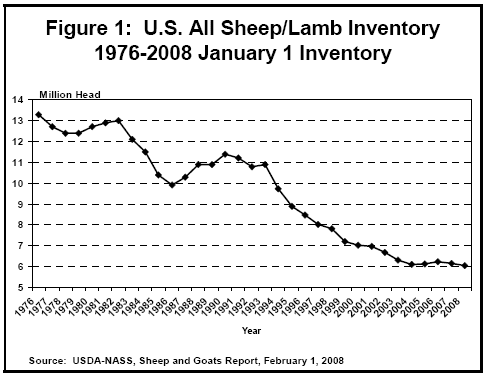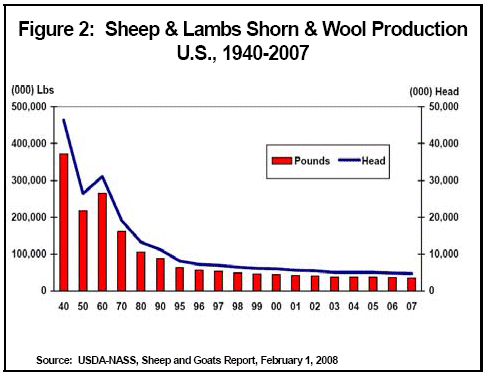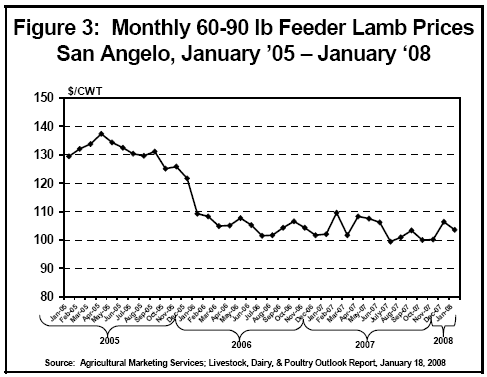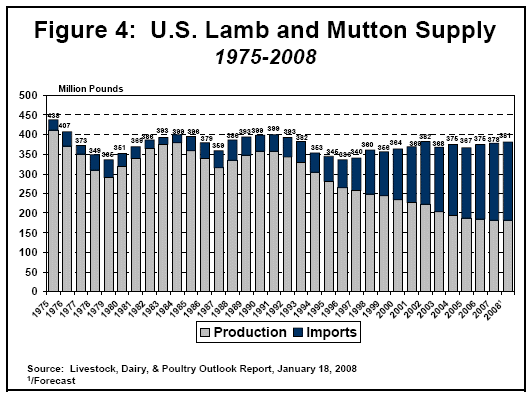AG-ECO NEWS
Vol. 24, Issue 4, February 15, 2008 – PDF version
Jose G. Peña
Texas AgriLife Extension Economist-Management
The U.S. Sheep Inventory Down for 2nd Year, After Two Years of Herd Rebuilding; Herd in Texas Down Five Percent
The U.S. sheep and lamb inventory declined for the 2nd year in a row after showing a modest increase for two consecutive years. According to USDA’s February 1, 2008 Sheep and Goats report, the size of the all sheep and lamb inventory in the U.S. on January 1, 2008, totaled 6.055 million head, down 1.8 percent from 2007 to the lowest inventory since the peak of 56.2 million head in 1942. The previous low point was in 2004 with 6.105 million head. (See Figure 1). It appears that the continuing dry weather in the Southwestern part of the U.S. and weakening of the lamb market encouraged the continuing liquidation of the sheep and lamb herd. The inventory decreased across all categories, with the number of ewes one year old and older dropping 2.1 percent and the size of the total breeding herd decreasing by 105,000 head (2.3%). The inventory of replacement lambs under one year old decreased 24,000 head (3.3%). This relatively large decrease in the inventory of ewe replacement lambs would indicate that the sheep inventory will continue to decline. The size of herd declined in 18 states, including Texas, and about 22 states showed a herd increase or no change to their herd size.
 Shorn wool production in the U.S. during 2007 at 34.5 million pounds was down 4.1 percent from 36 million pounds produced in 2006. Sheep and lambs shorn totaled 4.71 million head, down 3.0 percent from 4.85 million in 2006. (See Figure 2). The average price paid for wool sold in 2007, however, was $0.88 per pound, up 20 cents from an average price of $0.68 per pound in 2006. While production was down, the higher average price brought the total value of wool clip to $30.3 million up 23.5 percent from a value of $24.5 million in 2006 and up 15.2 percent from a value of $26.3 million two years ago.
Shorn wool production in the U.S. during 2007 at 34.5 million pounds was down 4.1 percent from 36 million pounds produced in 2006. Sheep and lambs shorn totaled 4.71 million head, down 3.0 percent from 4.85 million in 2006. (See Figure 2). The average price paid for wool sold in 2007, however, was $0.88 per pound, up 20 cents from an average price of $0.68 per pound in 2006. While production was down, the higher average price brought the total value of wool clip to $30.3 million up 23.5 percent from a value of $24.5 million in 2006 and up 15.2 percent from a value of $26.3 million two years ago.
 Lamb Prices Down
Lamb Prices Down
Wool, lamb and mutton (meat from sheep one-year old or older) are the products of the sheep industry. Feeder lamb prices have softened (see figure 3) significantly from 2005’s record highs and together with the continuing dry weather and high feed/energy costs may have encouraged the continuing liquidation of the U.S. Sheep herd.

Imports
While U.S. lamb and mutton supplies have remained fairly stable for the last 30 years (annual average of about 369 million pounds since 1998), imports rose rapidly in the mid-1990’s to fill the gap as U.S. production decreased and as lamb imports quickly found consumer acceptance in the U.S. (See Figure 4). Almost all of the U.S. lamb imports come from Australia and New Zealand. Imports account for close to half of domestic lamb and mutton consumption.
 Exports
Exports
The U.S. exports small quantities of lamb compared to its imports. Exports have increased during recent years, but the balance of trade weighs heavily on imports. In 2007, the U.S. exported about six million pounds of lamb and mutton, compared to about 196 million pounds which were imported that same year. Most of the U.S. mutton is exported to Mexico. Another key trading location for exports is Canada.
Per Capita Consumption
After dropping significantly to record lows in the mid-90’s, U.S. Lamb and Mutton per capita consumption has stabilized at about 1.1 pounds during the last four years. (See Figure 5). 
Texas Inventory Down
In Texas, the January 1, 2008 inventory decreased to one million head, down 4.8 percent from an inventory of 1.05 million head on January 1, 2007. Except for spring 2007, Southwest Texas, where most of the sheep and lambs reside, probably has suffered the severest part of the drought of 2006 and since fall 2007.
The inventory of breeding ewes, one year and older in Texas decreased by 35,000 head (down 5.3%) and the total breeding sheep and lamb inventory decreased by 40,000 head to 770,000 head on January 1, 2008, compared to a year ago. The inventory of replacement lambs dropped 5,000 head (down 4.8%) to 100,000 head. The herd in Texas had been steadily declining.
The inventory of 6.1 million head on January 1, 1961 in Texas alone was about the same size as the total current U.S. inventory. Texas remains the leading state with 17.0 percent of the total U.S. herd, compared to 17.5 percent a year ago.
